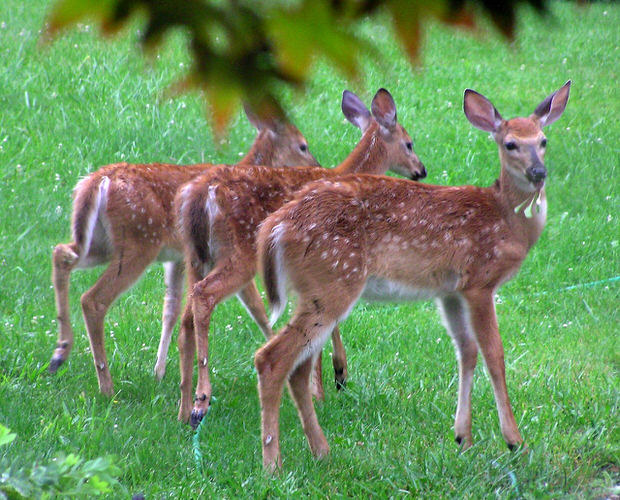






Oh, those darling little “Bambi’s”. I quickly get over the “Bambi Syndrome” when I see the deer eating the flowers and shrubs I have nurtured, and spent so much money to buy. How to keep deer out of your garden is a question that does not have one answer that will work forever. Because we have moved into the deer’s space, and they have adapted, we can expect for them to adapt to almost every deterrent we put forth to keep them away. The answer to keep deer out of your garden is to use a combination of methods, and to alternate those methods. Your vigilance needs to start early in the spring, because once the deer have a taste for certain plants they seem to work up their courage to continue eating that plant, no matter what deterrents are in place.
There are six main categories of methods to deter deer from making a smorgasbord out of your garden.
1. Physical barriers: These include fences, electric fences, and netting. Fences need to be 7-8 feet high, preferably with an additional section at the top slanting in. Using combinations of fences in different heights, and set parallel inside of each other is another method. Electric fencing can be used. Netting can also be wrapped around certain plants or shrubs to protect them. The biggest downside to fencing is that some neighborhoods do not allow the type of fencing that will keep deer out of the garden.
2. Scare Tactics. Noise, water sprays, throwing things, gunshots, and dogs, are some of these. There are commercial items that are set up by motion sensing, and water to go off when something moves in the yard. If I used that, I know I would forget, and the only “dear” that would get wet, would be me. Noise can scare deer away, but you would have to be out in the garden constantly to make it work. Gunshots in the air can also work, but only when you are there. Also, gunshots are not allowed in some areas. Dogs work by two methods. The noise method and the scent repellant method.
3. Repellents. Smelly soap, wax coatings, hair, urine, and eggs, is some of the list. Smelly soap, works well. You can get the kind of soap that comes in individual boxes, drill a hole in the center, and hang it in the garden with twine. Or hide the soap under plants on the ground. Wax coatings, hair, coyote urine, and egg combinations work also. However, I prefer the good smelling over the bad smelling repellents. The main purpose is to make the deer think there is an animal or human predator near.
4. Execution. Shoot them. Although it would only work on a limited basis, controlled harvesting, by having “in season” hunting is something that is debated by many. However, it is more humane than letting deer starve to death from over population, and a hard winter. This is not allowed in most city limits.
5. Remove attractions. Grow plants they do not like. In general, deer do not like anything with fuzzy leaves. Some great plants that deer do not like are: daffodils, foxglove, lambs ears, daylilies, heuchera, burning bush, butterfly bush, and hydrangea. There are many more selections. A good mail order nursery catalog will tell you which ones are resistant to deer. However, none are 100% deer proof. If a deer is hungry enough it will eat anything.
6. Distraction attractions. Feed them, or give salt lick. My neighbor feeds the deer. This is not always recommended, but it is working at this time. They go around the perimeter of my yard, and to the feeding spot in her yard. If she stops feeding them, it will become a problem.
In my garden the last two years I have used a strong deodorant soap, hung and placed strategically. I also plant a lot of deer resistant plants, and cover plants with netting that might be tempting to deer.
I still see the deer in the woods at the perimeter of our property, but they are not munching on my plants. This year, just for good measure, I am going to change the scent of the deodorant soap. Many methods will work, but a combination of methods, and changing those methods from time to time is best.
Article By Kathleen Couch. Kathleen Couch who also goes by the pen name of Purple Leaf has written a variety of articles. She has gained expertise in many areas by having rich and fulfilling life experiences. You may read more of her articles at this site: http://www.helium.com/user/show/32788
Copyright © www.100flowers.win Botanic Garden All Rights Reserved